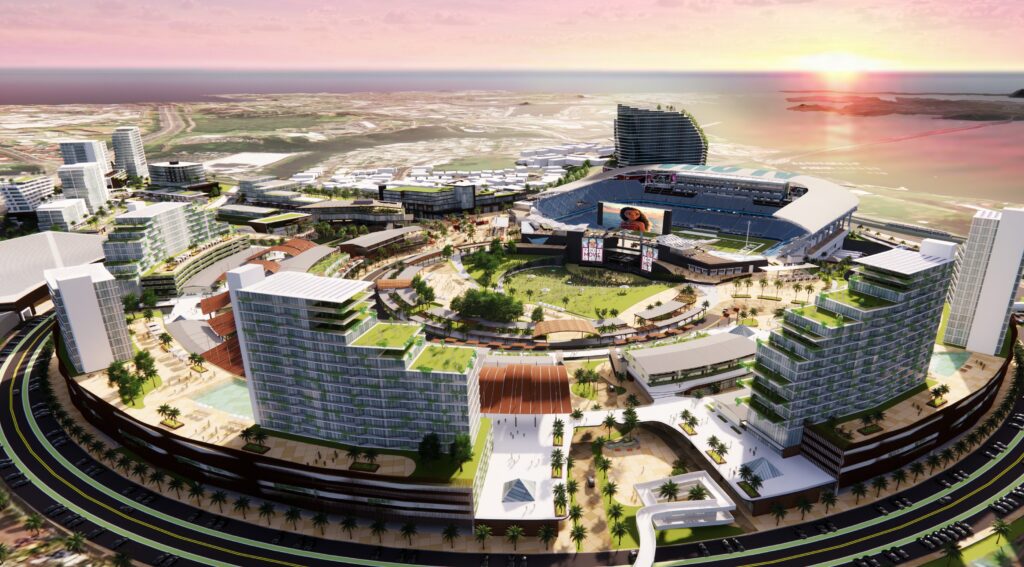
THREE DEVELOPER-LED TEAMS PRIORITY-LISTED FOLLOWING EVALUATION OF NASED RFQ RESPONSES
News Release from NASED, Wednesday, December 9, 2020
HONOLULU – Three highly qualified developer-led teams have been priority-listed by the state of Hawaii following a thorough review of responses the state received to a Request for Qualifications (RFQ) issued this past March for the New Aloha Stadium Entertainment District (NASED).
This RFQ includes the new Aloha Stadium complemented by a mix of developments that will connect the stadium to the Honolulu Authority for Rapid Transportation (HART) station.
The three developer-led teams include a mix of international expertise, national sports design and construction experience, and outstanding local industry talent.
“We are very fortunate to have been able to select three highly qualified potential partners who are as committed and passionate about moving the NASED forward as we are, particularly at this time when Hawaii needs to spur our economic recovery and sustainability,” said Chris Kinimaka, public works administrator for the Department of Accounting and General Services (DAGS).
The three developer-led teams that were priority-listed include:
Aloha Stadium District Partners, a consortium comprising of:
John Laing Investments Limited, Civil & Building North America Inc. and
Hawaiian Dredging Construction Company, Inc. as the lead equity members; NBBJ Hawaii, Inc. and RMA Architects as the design team; Civil & Building North America and Hawaiian Dredging Construction Company, Inc.as the construction team; and Aramark Management Services Limited Partnership and Honeywell International Inc. as the services (maintenance) provider;
Aloha Stadium Hui Hilina‘i, a consortium comprising of:
Plenary Americas US Holdings Inc. and PCL Investments Canada Inc. as the
lead equity members; M. Arthur Gensler Jr. & Associates, Inc. and KYA, Inc. as the design team; Nordic PCL Construction as the construction team; and
Johnson Controls, Inc. as the services (maintenance) provider;
Waiola Development Partners, a consortium comprising of:
EllisDon Capital Inc., Kobayashi Group LLC and BSC Acquisitions II, LLC as the lead equity members; Design Partners Incorporated and MANICA Architecture as the design team; Turner Construction Company and Nan, Inc. as the construction team; and Spectra as the services (maintenance) provider.
DAGS is actively paving the procurement path for the next step: the Request for Proposal (RFP) process. During this stage, each respondent will be required to propose their own designs for the new stadium, as well as their plan to construct, finance and maintain the facility, and a master
planning approach for the district.
The state is planning to commence the RFP process by mid-2021 and execute a contract with the selected public-private partnership (P3) development partner by year-end.
PATH TO RFP
On March 27, 2020, the State formally kicked off its process to select a developer to deliver the new stadium portion of the New Aloha Stadium Entertainment District by issuing a Request for Qualifications (RFQ) to the industry.
The goal of the RFQ, which was the first step in the two-stage process, was to identify qualified teams, based on their experience, capability, capacity, and other relevant factors. The final deadline for submittal was two months later, on May 26, 2020, and six responses were received.
The RFQ’s Evaluation Committee completed a thorough review of the submittals, which included analysis and input from various subject-matter experts. Given the quality of the bidding consortia, the evaluation committee met the challenge of shortlisting the field to three priority-listed teams, as was the goal of the RFQ.
The three priority-listed teams comprise consortia with highly skilled and credentialed members that are leaders in P3 development and stadium design, construction and maintenance industries, including major Hawaii-based construction and consultant firms.
NASED QUICK FACTS
The New Aloha Stadium Entertainment District (NASED) is envisioned to be a mixed-use development, offering a full complement of live, work, and play components, as well as community assets.
Below is a link to a flyby video that highlights concept renderings for the new Aloha Stadium and NASED, providing a virtual view of some preliminary possibilities for the 98-acre parcel of land. Click on the link to view the video: http://nased.hawaii.gov/about/
The flyby video displays three contemplated locations for the new Aloha Stadium that have been under consideration. The video also shows possible amenities that could be included in NASED.
NASED will appeal to a wide variety of people, including both residents and visitors. Proposed amenities include entertainment venues, retail stores, restaurants, housing, hotels, recreational sites, cultural amenities, green space, etc.
From opening day of the new Aloha Stadium, NASED will be a vibrant, mixed-use district that will build up over time as the development continues to grow.
An EIS and master planning process is underway and is expected to be completed by fall 2021.
The EIS is known as a “Programmatic EIS,” which means that a mix of uses for the Halawa site is required, while stipulating that a range (maximum and minimum) of development area for each use must be satisfied. This is to ensure that the desire for a vibrant, mixed-use project is delivered.
With the COVID-19 pandemic’s negative impacts to the state economy, even greater, long-lasting benefits may be realized with expedited development of the new Aloha Stadium and the Stadium Development District.
---30---
SA: 3 finalists to build, design new Aloha Stadium announced
SA: New Aloha Stadium Entertainment District finalists selected
SA Editorial: A new Aloha Stadium